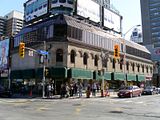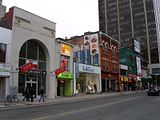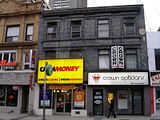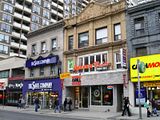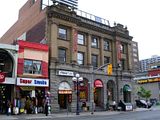barrytron3030
Active Member
from today's toronto star. i'd love to see some pictures of the area, maybe i'll walk there tomorrow.
PUBLIC SPACE
The Gardiner's accidental wilds
Last year, the city launched a plan to improve some of our most neglected, and oddly alluring, sidewalks. We check in on the effort
Jan 10, 2009 04:30 AM
CHRISTOPHER HUME
URBAN AFFAIRS COLUMNIST
Whether nature is dead, dying or has just moved downtown, recognizing it has grown harder than ever.
In the city, where nature comes in unexpected forms, the urban naturalist must learn new ways of seeing. The best example may be the Gardiner Expressway. It is no longer merely an elevated highway; it has become a linear subterranean ecosystem, man-made but never quite under control. In the perpetual shadow of a structure built long ago in a now dead future, newly arrived dog walkers from nearby condos rub shoulders with homeless men off for a day's begging and workers hurrying to the office.
Though none of this activity was anticipated, let alone intended, the city launched a streetscape-improvement program last year apparently aimed at bringing order to this emerging natural system. On Yonge St. south of The Esplanade and the railway overpass, sidewalks have been widened and large concrete flower beds installed along the east side of Yonge directly beneath the Gardiner. At this point, the elevated highway has no fewer than three branches.
To the west, new paths lead from Yonge to Bay, where they suddenly stop. The trail picks up again on the other side of Bay and, with a few detours, moves through a forgotten but appealing space defined by the curve of the Gardiner's York St. exit. This small, circular clearing would be an oasis but for the fact the drinking fountain doesn't work.
From there, the path leads west to John St. and the manufactured meadow that forms the (green) roof of the southern half of the Metro Convention Centre. It offers one of the best views of the Gardiner's westbound lanes and Lake Shore Blvd., which rushes through the city like a river during spring runoff. The twice-daily torrent empties not into Lake Ontario, of course, but the ocean of sprawl that surrounds the city.
East of Yonge, the path runs parallel to Lake Shore Blvd. all the way to Parliament St., where it connects with the Martin Goodman Trail. Things are rougher here, mostly because there are fewer access points.
For non-human urban wildlife, this is where things get tricky. The coyotes that roam the Leslie Street Spit generally travel down the Don Valley and can easily end up having to cross the six-or-more-lane highway. It's one thing to see deer grazing on the side of the Don Valley Parkway, another to encounter a fox at the corner of Lake Shore and York. The truth, however, is that most wildlife in this part of the city is human, not necessarily bipedal. Though urban hikers have yet to discover this still evolving trail system, those who do are rewarded with first-hand encounters with Toronto's soft, make that muddy, underbelly. This is where the infrastructure reveals itself, reaches out of the ground like some massive geological element and becomes the landscape.
The Lake Shore is a river, with vehicles instead of water, the Gardiner a grotto. The Convention Centre is the hilly region and utility poles stand in for the trees.
Although the sun never shines in this part of town, many denizens seem to prefer it that way. Consider the city's reaction when the ramp at the east end of the Gardiner was torn down in a fit of civic zeal nearly a decade ago: It was immediately replaced with a big-box shopping complex that casts an even darker shadow.
So it's no surprise people are starting to be attracted to this troglodytic world. Far from the madding crowd, not to mention nicely protected from the cars hurtling above, this may be Toronto's final frontier. Except for the waterfront, where the landscape is heading into a period of planned evolution, the Gardiner corridor is the city's last accidental wilderness of any significance.
Given its proximity to downtown and the waterfront, and the fact that it's unlikely to be torn down, the time has come to revisit the Gardiner. Needless to say, it should be torn down, but Toronto doesn't have the political will to embark on such a bold and controversial course. In other words, this wilderness will be around for a while.
These paths and trails, still unfinished, remain largely unused and unexplored. Therein lies their appeal, or lack thereof, depending on your point of view.
But nature's like that; for all the talk of its restorative powers, it can be brutal and unforgiving, or just shadowy and elusive.
PUBLIC SPACE
The Gardiner's accidental wilds
Last year, the city launched a plan to improve some of our most neglected, and oddly alluring, sidewalks. We check in on the effort
Jan 10, 2009 04:30 AM
CHRISTOPHER HUME
URBAN AFFAIRS COLUMNIST
Whether nature is dead, dying or has just moved downtown, recognizing it has grown harder than ever.
In the city, where nature comes in unexpected forms, the urban naturalist must learn new ways of seeing. The best example may be the Gardiner Expressway. It is no longer merely an elevated highway; it has become a linear subterranean ecosystem, man-made but never quite under control. In the perpetual shadow of a structure built long ago in a now dead future, newly arrived dog walkers from nearby condos rub shoulders with homeless men off for a day's begging and workers hurrying to the office.
Though none of this activity was anticipated, let alone intended, the city launched a streetscape-improvement program last year apparently aimed at bringing order to this emerging natural system. On Yonge St. south of The Esplanade and the railway overpass, sidewalks have been widened and large concrete flower beds installed along the east side of Yonge directly beneath the Gardiner. At this point, the elevated highway has no fewer than three branches.
To the west, new paths lead from Yonge to Bay, where they suddenly stop. The trail picks up again on the other side of Bay and, with a few detours, moves through a forgotten but appealing space defined by the curve of the Gardiner's York St. exit. This small, circular clearing would be an oasis but for the fact the drinking fountain doesn't work.
From there, the path leads west to John St. and the manufactured meadow that forms the (green) roof of the southern half of the Metro Convention Centre. It offers one of the best views of the Gardiner's westbound lanes and Lake Shore Blvd., which rushes through the city like a river during spring runoff. The twice-daily torrent empties not into Lake Ontario, of course, but the ocean of sprawl that surrounds the city.
East of Yonge, the path runs parallel to Lake Shore Blvd. all the way to Parliament St., where it connects with the Martin Goodman Trail. Things are rougher here, mostly because there are fewer access points.
For non-human urban wildlife, this is where things get tricky. The coyotes that roam the Leslie Street Spit generally travel down the Don Valley and can easily end up having to cross the six-or-more-lane highway. It's one thing to see deer grazing on the side of the Don Valley Parkway, another to encounter a fox at the corner of Lake Shore and York. The truth, however, is that most wildlife in this part of the city is human, not necessarily bipedal. Though urban hikers have yet to discover this still evolving trail system, those who do are rewarded with first-hand encounters with Toronto's soft, make that muddy, underbelly. This is where the infrastructure reveals itself, reaches out of the ground like some massive geological element and becomes the landscape.
The Lake Shore is a river, with vehicles instead of water, the Gardiner a grotto. The Convention Centre is the hilly region and utility poles stand in for the trees.
Although the sun never shines in this part of town, many denizens seem to prefer it that way. Consider the city's reaction when the ramp at the east end of the Gardiner was torn down in a fit of civic zeal nearly a decade ago: It was immediately replaced with a big-box shopping complex that casts an even darker shadow.
So it's no surprise people are starting to be attracted to this troglodytic world. Far from the madding crowd, not to mention nicely protected from the cars hurtling above, this may be Toronto's final frontier. Except for the waterfront, where the landscape is heading into a period of planned evolution, the Gardiner corridor is the city's last accidental wilderness of any significance.
Given its proximity to downtown and the waterfront, and the fact that it's unlikely to be torn down, the time has come to revisit the Gardiner. Needless to say, it should be torn down, but Toronto doesn't have the political will to embark on such a bold and controversial course. In other words, this wilderness will be around for a while.
These paths and trails, still unfinished, remain largely unused and unexplored. Therein lies their appeal, or lack thereof, depending on your point of view.
But nature's like that; for all the talk of its restorative powers, it can be brutal and unforgiving, or just shadowy and elusive.





